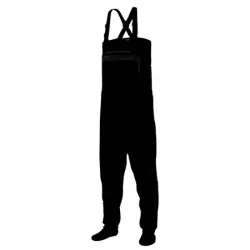Waders are an indispensable piece of gear for anglers, hunters, and outdoor enthusiasts. They keep you dry and comfortable while you wade through water, mud, and other challenging environments. However, to ensure your waders perform at their best and last for many seasons, it's crucial to know how often and how to clean them properly. This article will delve into the specifics of washing waders, including breathable waders, neoprene waders, and the importance of maintaining their durable water repellent (DWR) coatings.
Key Takeaways:
- Regular cleaning of waders is essential for maintaining their performance and longevity.
- Different types of waders require specific cleaning methods to preserve their materials and coatings.
- Proper storage and drying techniques are crucial to prevent damage and ensure waders remain effective.

Understanding the Importance of Cleaning Your Waders
Waders are exposed to various elements, including dirt, fish slime, and other contaminants. Over time, these substances can degrade the materials and coatings of your waders, reducing their effectiveness. Regular cleaning helps remove these contaminants and maintain the waders' performance. Additionally, proper cleaning can prevent the growth of mold and mildew, which can cause unpleasant odors and damage the fabric.
Cleaning your waders also helps preserve the DWR coating, which is essential for maintaining water repellency. The DWR coating allows water to bead up and roll off the fabric, keeping you dry. Without regular cleaning, dirt and grime can clog the pores of the fabric, reducing its breathability and water repellency.

How Often Should You Wash Your Waders?
The frequency of washing your waders depends on how often you use them and the conditions in which you use them. As a general rule, it's a good idea to wash your waders after every few uses, especially if they've been exposed to saltwater, mud, or other harsh conditions. If you use your waders frequently, consider washing them every few weeks to keep them in top condition.
For those who use their waders less frequently, a thorough cleaning at the end of each season should suffice. However, if you notice any buildup of dirt, grime, or odors, it's best to clean them sooner. Regular inspections can help you determine when it's time for a wash.
Cleaning Breathable Waders
Breathable waders, such as those made from Gore-Tex or other technical fabrics, require special care to maintain their performance. Start by rinsing off any loose dirt and debris with fresh water. Avoid using a pressure washer, as it can damage the fabric and seam tape.
Next, fill a tub or basin with cold water and add a small amount of a residue-free product like Ivory Snow Unscented Powder or a specialized sport wash. Gently hand wash the waders, paying extra attention to any heavily soiled areas. Avoid using harsh detergents or fabric softeners, as they can adversely affect the DWR coating and breathable fabric.
Drying and Storing Breathable Waders
After washing, it's crucial to dry your waders thoroughly to prevent mold and mildew growth. Hang your waders in a well-ventilated area, away from direct sunlight and heat sources. Ensure they are completely dry before storing them. Hanging waders by the shoulder straps or using a wader bag can help maintain their shape and prevent creases.
Proper storage is also essential for prolonging the life of your waders. Store them in a cool, dry place, away from direct sunlight and extreme temperatures. Avoid folding or crumpling the waders, as this can damage the fabric and seam tape.
Cleaning Neoprene Waders
Neoprene waders are known for their durability and insulation, making them ideal for cold water conditions. Cleaning neoprene waders is relatively straightforward. Start by rinsing off any loose dirt and debris with fresh water. Fill a tub or basin with warm water and add a small amount of a mild, dye-free detergent.
Gently hand wash the waders, paying extra attention to any heavily soiled areas. Avoid using hot water, as it can damage the neoprene material. Rinse thoroughly to remove any detergent residues, as they can cause the neoprene to deteriorate over time.
Drying and Storing Neoprene Waders
Drying neoprene waders requires a bit more care than breathable waders. After washing, turn the waders inside out and hang them in a well-ventilated area to dry. Once the inside is completely dry, turn them right side out and allow the outside to dry. This two-step process helps prevent mold and mildew growth.
When storing neoprene waders, avoid folding or crumpling them, as this can cause creases and damage the material. Hang them by the shoulder straps or store them flat in a cool, dry place. Proper storage helps maintain the waders' shape and prolongs their lifespan.
Maintaining the DWR Coating
The DWR (durable water repellency) coating is essential for maintaining the water repellency of your waders. Over time, this coating can wear off, reducing the waders' effectiveness. To restore the DWR coating, you can use a specialized DWR treatment product. Follow the manufacturer's instructions for application, and ensure the waders are clean and dry before applying the treatment.
Regularly inspecting your waders for signs of wear and tear can help you determine when it's time to reapply the DWR coating. If you notice water no longer beading up on the surface, it's a good indication that the coating needs to be refreshed.
Avoiding Common Mistakes
When cleaning your waders, it's important to avoid common mistakes that can damage the fabric and reduce their effectiveness. Avoid using harsh detergents, fabric softeners, or bleach, as these can degrade the materials and coatings. Stick to mild, dye-free detergents or specialized sport washes.
Additionally, avoid using a pressure washer or scrubbing the fabric too vigorously, as this can damage the seam tape and breathable membranes. Always rinse thoroughly to remove any detergent residues, and ensure the waders are completely dry before storing them.
Proper Storage Techniques
Proper storage is crucial for maintaining the performance and longevity of your waders. After cleaning and drying, store your waders in a cool, dry place, away from direct sunlight and extreme temperatures. Hanging waders by the shoulder straps or using a wader bag can help maintain their shape and prevent creases.
Avoid folding or crumpling the waders, as this can damage the fabric and seam tape. If you need to transport your waders, consider using a taco bag or a closed bag to protect them from dirt and damage.
The Role of Wading Boots and Accessories
Wading boots and accessories, such as wading belts and neoprene feet, also require regular cleaning and maintenance. Rinse off any dirt and debris with fresh water, and allow them to dry thoroughly before storing. Proper care of your wading boots and accessories helps ensure they perform at their best and last for many seasons.
Inspect your wading boots regularly for signs of wear and tear, and replace them as needed. Properly fitting wading boots and accessories can enhance your comfort and safety while wading.

Conclusion
Regular cleaning and proper maintenance of your waders are essential for ensuring their performance and longevity. By following the guidelines outlined in this article, you can keep your waders in top condition and enjoy many seasons of comfortable and dry wading. Remember to clean your waders after every few uses, avoid common mistakes, and store them properly to prevent damage.

FAQs
How often should I wash my waders?
How often you should wash waders depends on how often you use them and the conditions in which you use them. As a general rule, it's a good idea to wash your waders after every few uses, especially if they've been exposed to saltwater, mud, or other harsh conditions. If you use your waders frequently, consider washing them every few weeks to keep them in top condition.
Can I use a washing machine to clean my waders?
While some waders can be cleaned in a washing machine, it's generally best to hand wash them to avoid damaging the fabric and seam tape. If you do use a washing machine, use a front-load machine on a gentle cycle with cold water and a mild, dye-free detergent. Avoid using fabric softener or bleach, and always air dry your waders.
How do I restore the DWR coating on my waders?
To restore the DWR coating on your waders, you can use a specialized DWR treatment product. Follow the manufacturer's instructions for application, and ensure the waders are clean and dry before applying the treatment. Regularly inspecting your waders for signs of wear and tear can help you determine when it's time to reapply the DWR coating.
Related articles:











